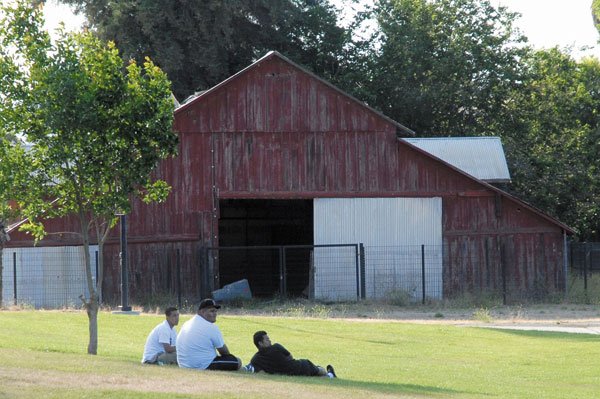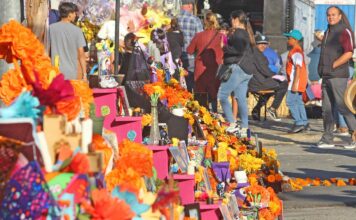An iconic fixture lodged on the ranch side of Christmas Hill Park – a weathered relic for more than a century of Gilroy’s storied farming heritage – is on course toward demolition if private investors don’t step up to the plate.
City Council voted unanimously Monday night to recommend demolition of the familiar yet long-neglected “Red Barn,” as locals know it, putting its foot down on a can that’s been kicked around the community for the better part of 23 years as other more pressing issues took priority.
The vote included two conditions, however. The City must first advertise to gauge any interest from private citizens and businesses in moving and relocating the barn to another site. And if the barn does get demolished, wood from the original structure must be re-purposed as a special interior wall display in the lobby or in a couple rooms of a new City-owned building.
“Depending on the outcome of that, we’ll either work with the interested party in (relocation) or we’ll prepare the demolition plans,” said Gilroy Operations Manager David Stubchaer.
That process would entail advertising for the bid, a formal award of the contract and the actual demolition, which would occur between Feb. 1 and Aug. 15, 2014, so as to not interfere with the bird and bat nesting season, according to Stubchaer.
The City’s demolition plans also extend to a nearby modular trailer and a ranch house adjacent to the barn. Total demolition costs are estimated to be $104,563, according to Stubchaer, including asbestos removal and disposal, allowing the Historic Heritage Committee to select material for future use and potential reuse and a $1,000 photographic documentation of the barn prior to demolition.
Downtown advocate and local developer, Gary Walton, said he was disappointed to hear demolition was slated for such a “significant” piece of Gilroy’s history.
“We could have used it for the community in terms of tying in our agricultural history and the history of that barn – something that could have been a better solution than demolition,” Walton said. “We seem to be tearing down the City’s history one piece at a time. When you really start looking at what we’re losing year after year, it’s really significant. We’re losing a lot of the community’s identity.”
Walton points to the City of Santa Clara, which in the 1960s decided to demolish its downtown and is now “very tough” on historical preservation.
“Sometimes, you don’t realize what you’re losing until it’s all gone,” he added. “On the barn, there doesn’t seem to be a lot of out-of-the-box thinking in terms of how we could have kept that building as a community asset. It seems like the only thing on the table was just to get rid of it. The City needs to start realizing that when you cut down your historical trees, tear down historic buildings or promote the destruction of historic neighborhoods, you’re losing a piece of your identity – what makes you unique and what makes you special.”
Once a farming and recreation building erected in the late 1800s to early 1900s, the 5,368-square-foot structure sits unused and boarded up behind a padlocked 7-foot-tall chain link fence. It was sealed shut in the mid-1990s due to disrepair, but until 2004, the Garlic Festival Association was at least allowed to store its signs inside the facility during the event’s off-season. Nowadays, the only beings going in and out of the space are hoards of Mexican free-tailed bats, birds and cats.
“I’d like to see them disassemble (the Red Barn), save the lumber for either City projects or for people wanting to purchase it because those are the requests I’ve had,” said Mayor Don Gage. “But it’s unsafe and it has to come down; it wouldn’t be worth the money to keep it going. I think the right decision was made.”
Demolishing the barn comes with the blessing of the Gilroy Historic Heritage Committee, who in November 2006 gave its approval since the structure was in “very poor” physical shape, unsafe to occupy and unhealthy for humans due to the volume of creatures nesting inside.
If the City were to take on the building’s revival, it would have to fasten all existing corrugated sheet metal roofing, replace any missing sheet metal panels and cover all vents with wire mesh to prevent animals from entering the barn, according to a 2004 report presented to City Council by Albert Salvador, building division manager with San Mateo-based CSG Consultants, Inc. Vertical supports along the north wall and other locations in the structure also have dry rot, according to Salvador.
He did present “cost effective” recommendations that would mitigate structural deficiencies, minimize health hazards and provide the City with a safe and clean barn and a storage facility for community use.
But the City later determined that even making repairs to use the barn for storage, opposed to retrofitting it for public use, was not cost effective and that the barn should be cleared and demolished, according to Stubchaer.
President Connie Rogers of the Gilroy Historical Society said she recalls the 2006 meeting where the Historic Heritage Committee first approved the demolition recommendation. But she does not remember hearing about Salvador’s report suggesting a few stopgap measures that could have prolonged the life of the Red Barn. Instead, she said the City approached the ranch site through “demolition by neglect.”
“I was at the HHC meeting where they voted for demolition; (Salvador’s information) was never presented there,” she said. “What it tells me is that somebody who was doing budgeting said it’s not a good use of our money to spend the limited resources we have on maintaining this old barn – so we’ll let it go, decay further and further and we do plan to replace it eventually.”
Rogers posits that the late Gilroy cattle baron Henry Miller owned the barn, based on her examination of an 1876 map listing him as a property owner. Between 1863 and 1916, Miller was one of the largest property owners in the United States with a total of 1.5 million acres. And that only adds to the historic and societal importance of the Red Barn, Rogers maintains.
“It’s a nice looking barn and I think besides its historic value – which hasn’t really been recognized – it does add a lot of aesthetic value to the park,” she said. “It’s been there since almost everyone in Gilroy can remember it being there. The barn, because it’s a large structure and it’s painted red, just looks cool.”
As proposed by a consulting firm in May of 2006, a brand new Ranch Site Community Center could be erected in place of the old Red Barn. Plans depict a two-story, 13,450-square-foot building with meeting rooms, a reception area, multipurpose room, patio areas, an office and a commercial kitchen. Original estimates put the cost between $3.5 million and $4.2 million.
“If the money’s there, we certainly can do it,” Gage added. “But we already have a community center – which is the Senior Center – so probably, a better use is to build more fields out there.”
Discussion of the potential new building was not on the table Monday night, Stubchaer stressed, and won’t come before Council until the Red Barn site is either relocated or demolished.
Gilroy Historical Society member Carol DeSantis concurs with Rogers that the Red Barn was likely built while Miller was alive – she even calls it the “Miller Red Barn.” She is urging City Council to reconsider inching toward demolition.
“(It) is the kind of building that has become iconic for many, many people in this community,” DeSantis said. “Over the years, I have never had a conversation with anyone in this City in which the subject of the barn came up when there wasn’t an immediate smile. I think that Council is making a very great political mistake in voting down the barn.”














